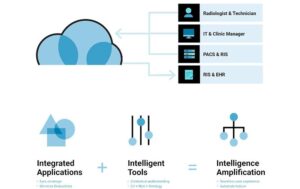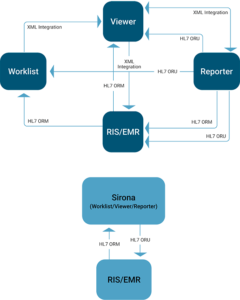You Too Can Prevent an IT Fire
Before I joined Sirona, the concept of a deconstructed PACS where you use the best products from individual vendors for worklist, viewer and reporter seemed like a good idea in theory. In practice, I knew firsthand just how difficult it was to get these individual products to work together. A simple software patch or upgrade could break the integration— it was a constant headache. So when I sat down with Sirona CEO Cameron Andrews and heard him explain RadOS— a fully integrated, cloud- native product built from the ground up— it was music to my ears. To have a single code base across the fundamental pillars of a rad’s workspace obliterates the need for custom integration and any concerns about upgrading/future proofing, which is great news for anyone whose job it is to keep the system running.
Implementation without disruption
Now that I’m with Sirona, I’ve been helping to build an app that can be implemented without disrupting the delicate ecosystemsthat IT managers and PACS admins have built and nurtured over many years. Having battled to keep data in sync across separate apps and systems, I understand why an IT manager might be a little nervous when their CIO says they’re thinking about an upgrade, or a rad starts making noise about a bright new piece of software. I might have spent weeks trying to get one app to talk to another and months or even years to build a server infrastructure to enable the install— the last thing I would want is to have to do it all over. Recognizing this, we have developed Sirona so it can be implemented as an overlay. This allows for integration with existing EMRs and DICOM/HL7 feeds, which in turn enables rads to evaluate the product using live reads without the need for extensive IT resources to make it happen.
Sirona System Integration Schematic

Sirona’s Zero Infrastructure Footprint
The Sirona approach is completely different from the rip & replace model we have become so used to in the industry. I can remember having to set up as many as 15 different servers for one vendor, and then the painstaking task of enabling interface servers, application servers, DICOM engines, etc. to talk to each other. Besides being tedious and costly, a system that speaks so many different languages is a constant day-to-day headache for the IT staff who are tasked with keeping it running. So we made Sirona’s infrastructure footprint zero at the initial evaluation stage – it only requires studies to be routed from an existing PACS/RIS. Sirona is simply another destination to add to an existing routing scheme, and although Sirona’s platform contains multiple functionalities, the integration requirement will only ever be for one app.

The above diagram compares Sirona’s data flow with the highly complicated flow seen in many systems today, which is further complicated by each vendor having their preferred means of integration at desktop level, i.e. XML file drop, COM or other proprietary mechanism.
Evaluate with live reads and full load test
Another issue with a rip & replace implementation is the difficulty in trialing a new product. Building a mini test environment is yet another complicated task, and once built, it can only simulate the front-end functionality of a new app. With no live reads and no means to accurately load-test, serious teething problems are inevitable after the ‘go live’ date. Sirona, on the other hand, is a bidirectional solution that enables live reads from the moment studies are routed to it, with all necessary data sent back to the relevant systems. To make sure this process runs smoothly, Sirona will normalize the data before any trial/implementation. If you’ve ever had to go through this labor-intensive process, you’ll know that for a larger clinic with multiple downstream clients it might take 100+ hours of internal resources to normalize data… but not with Sirona!
It’s time we had the cloud conversation
All of the above is only possible because Sirona is cloud-native. Like many in this sector, I have had my doubts about the cloud’s ability to provide the levels of stability and control that an IT manager/PACS admin needs, but there are benefits to moving away from the old-fashioned hardware stack. Because there’s no hardware to maintain, you immediately remove a local point of failure, and as already discussed, implementation and integration is far easier with the plug & play-style of install that the cloud enables. The day-to-day administration of a cloud-based overlay is also much more efficient. The real issue is getting to a level of trust in the cloud so there’s peace of mind that the system will remain stable 24/7. But isn’t that the same as placing your trust in a server in your place of work when you go home at night? As long as the cloud system offers equal or better uptime and enough manual control to fix any problems as they come, the physical location of the servers should be irrelevant.
Using the cloud to future proof in an era of remote working
Even before COVID, an increasing amount of IT support was dedicated to fighting fires caused by rads working remotely. Before anyone can do a read, all the relevant clients had to be installed on a local workstation and integrated with one another, and then virtual workstations set up for each facility the rad reads for. And what happens if an upgrade is needed? Even if upgrades can be pushed out remotely, the workstation needs to be online to receive it. A system with so many links in the chain, combined with variable local machines, is a recipe for disaster. Instead Sirona’s operational requirement is simply a web browser and internet connection. In a world that is moving increasingly towards flexibility in the workplace, I’d be much more confident I could move with the times if the systems I managed every day were based on the cloud and integrated from the moment they came out of the box. This is the future!
Vijay Veluri is Sirona’s Head of Integration and works closely with customers to set up the appropriate data feeds and system configurations. He has been an IT manager for multiple facilities, most recently at Stanford Children’s Hospital.